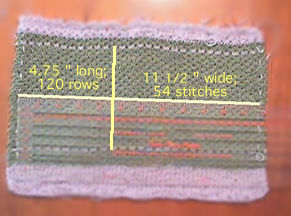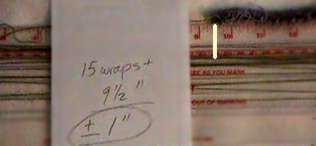After treating the swatch, I measured the length of the swatch from horizontal marker row to marker row. The distance between the 120 rows was 4.75".
The width between the vertical marker threads was 11 1/2"; the number of stitches was 54. (This swatch is much wider than I usually knit!)
Notice:
- Tuck stitches tend to provide extremely large stitch gauges relative to row gauges. Because they are also beautiful, you should consider them when making dresses that need to drape around womanly hips!
- My knit marker rows are wavy. I just measured a few lengths and averaged. If your stitch is very wavy, make sure you make a nice long swatch.

The gauge form will have a portion that looks sort of like the piece of form shown at the right. The words "Main swatch" indicate that you need to provide data for the main swatch. Now, enter the data you collect for your swatch in the appropriate boxes. I've entered mine for the swatch used in this example.
A similar entry region for "welt" data will appear on the design form. Just make a welt swatch (e.g. ribbing swatch) and collect similar information.
Step 5: When you run the program, your gauge will be calculated. You will see the boxes right on the form.

